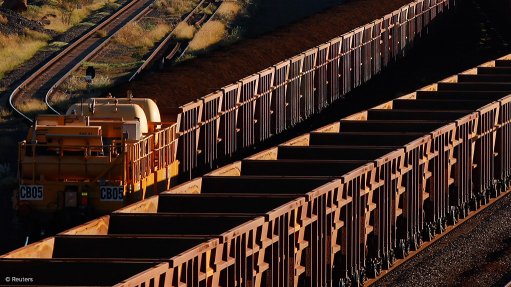Productivity at SA gold, platinum mines declined 49% from 1999 to 2014 – Chamber of Mines
Productivity in the platinum and gold mining sectors declined by 49% from 1999 to 2014, while labour costs increased by about 309% during the same period, Chamber of Mines (CoM) modernisation and safety intern Katlego Letsoalo noted earlier this month during the Southern African Institute of Mining and Metallurgy Young Professionals conference.
At the conference, held at the Innovation Hub, in Pretoria, he said, during the mining industry’s peak in the early 2000s, one miner produced 2 kg/m of gold and about 2.3 kg/m of platinum. The industry’s contribution to South Africa’s gross domestic product has also dropped significantly over the years, contributing only about 7.7% in 2015.
Letsoalo suggested that the reason for the steady decline in South Africa’s production was a lack of change in the industry, which, he stated, had remained much the same in the last 100 years.
“It looks like we are going back to where mining started,” he said.
However, despite its poor production levels, the local industry remains key to the economic growth of the country, particularly as it is ranked as one of the most resource-rich nations in the world, particularly in terms of gold and platinum.
Letsoalo pointed out that studies of three primary gold producers in South Africa found that the life-of-mine (LoM) of these operations could be extended if the cutoff grade were reduced by 1 g/t of gold. This was particularly important, since the general trend among gold operations had been to close down, he pointed out.
Significant platinum reserves in South Africa are located at depths of between 2 km and 4 km; however, Letsoalo pointed out, the deepest platinum mine in the country currently operated at a depth of about 2.2 km. “We need to change our systems to exploit the reserves and resources that lie at these deep levels,” he stated.
Mining Phakisa, a government-led initiative that was launched in 2015, aimed to address the current challenges of the mining industry, most notably the low production levels of South African operations, and to stabilise the industry, Letsoalo added.
Some of the outcomes of the initiative have been the establishment of a mining equipment manufacturing cluster, the Mining Equipment Manufacturing of South Africa, and a CoM-led initiative in support of Mining Phakisa focused on research and development (R&D).
Letsoalo highlighted that the CoM had subsequently agreed with its member companies to focus R&D on the platinum and gold sectors.
The first area of research identified by the CoM would focus on the modernisation of current operations, but, Letsoalo noted, not all operations would be adaptable to mechanisation. “The biggest question is . . . [the] changes [we can] bring about to reduce costs, improve health and safety, and extend, in any way possible, the available LoM [of current operations].”
The second area of research will focus on mechanisation, especially for drilling and blasting operations, particularly by improving operations through the introduction and local development of new technology.
Research is also being done in the field of nonexplosive rock-breaking technology. However, Letsoalo pointed out that there already were a number of “international original-equipment manufacturers operating in this space, but the challenge for the local industry is to develop solutions that are specifically designed for South Africa’s unique narrow-reef [conditions]”.
Underlying this is research focused on the development of advanced orebody knowledge, real-time information management systems and human factors such as resistance to change and transformation of the industry, as well as skills development.
Letsoalo noted that the introduction of new technologies forced local mining companies to reconsider how they developed geological models and systems that would enable mines to make real-time operational decisions using real-time geological inputs.
“The concept of information management will require that mining companies develop systems for deep narrow-reef operations that . . . improve the information that the mines are gathering, the communication systems that they use and the reliability of the data they are receiving,” he concluded.
Comments
Press Office
Announcements
What's On
Subscribe to improve your user experience...
Option 1 (equivalent of R125 a month):
Receive a weekly copy of Creamer Media's Engineering News & Mining Weekly magazine
(print copy for those in South Africa and e-magazine for those outside of South Africa)
Receive daily email newsletters
Access to full search results
Access archive of magazine back copies
Access to Projects in Progress
Access to ONE Research Report of your choice in PDF format
Option 2 (equivalent of R375 a month):
All benefits from Option 1
PLUS
Access to Creamer Media's Research Channel Africa for ALL Research Reports, in PDF format, on various industrial and mining sectors
including Electricity; Water; Energy Transition; Hydrogen; Roads, Rail and Ports; Coal; Gold; Platinum; Battery Metals; etc.
Already a subscriber?
Forgotten your password?
Receive weekly copy of Creamer Media's Engineering News & Mining Weekly magazine (print copy for those in South Africa and e-magazine for those outside of South Africa)
➕
Recieve daily email newsletters
➕
Access to full search results
➕
Access archive of magazine back copies
➕
Access to Projects in Progress
➕
Access to ONE Research Report of your choice in PDF format
RESEARCH CHANNEL AFRICA
R4500 (equivalent of R375 a month)
SUBSCRIBEAll benefits from Option 1
➕
Access to Creamer Media's Research Channel Africa for ALL Research Reports on various industrial and mining sectors, in PDF format, including on:
Electricity
➕
Water
➕
Energy Transition
➕
Hydrogen
➕
Roads, Rail and Ports
➕
Coal
➕
Gold
➕
Platinum
➕
Battery Metals
➕
etc.
Receive all benefits from Option 1 or Option 2 delivered to numerous people at your company
➕
Multiple User names and Passwords for simultaneous log-ins
➕
Intranet integration access to all in your organisation


















